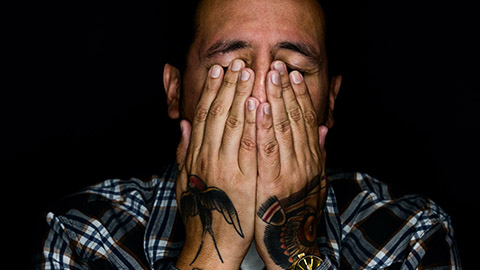07/29/2021

Chronic fatigue syndrome (CFS), called myalgic encephalomyelopathy (ME) in other countries, is one of my least favorite topics. It is just so slippery, and we understand very little about how it comes about, how to treat it, and how massage therapy might help. We are likely to see more cases of CFS/ME soon, as this symptomatic profile is common in people with long COVID. What is chronic fatigue? And how can massage therapy be helpful? Join me for an exploration of this complex and frustrating topic to get to some possible solutions for a client who lives in pain.
Resources:
Alraek, T. et al. “Complementary and Alternative Medicine for Patients with Chronic Fatigue Syndrome: A Systematic Review,” BMC Complementary and Alternative Medicine 11 (2011): 87. https://doi.org/10.1186/1472-6882-11-87.
Foundation for Mitochondrial Medicine. “Chronic Fatigue Syndrome.” May 24, 2018. http://mitochondrialdiseases.org/related-diseases/chronic-fatigue.
Jacobson, Eric. “Structural Integration, an Alternative Method of Manual Therapy and Sensorimotor Education,” Journal of Alternative and Complementary Medicine 17, no 10 (2011): 891–99. https://doi.org/10.1089/acm.2010.0258.
Jones, James. F. et al. “Complementary and Alternative Medical Therapy Utilization by People with Chronic Fatiguing Illnesses in the United States,” BMC Complementary and Alternative Medicine 7 (2007): 12. https://doi.org/10.1186/1472-6882-7-12.
MECFS_KeyFacts.pdf. Accessed July 2021. www.nationalacademies.org/hmd/~/media/Files/Report%20Files/2015/MECFS/MECFS_KeyFacts.pdf.
NINDS. “Myalgic Encephalomyelitis/Chronic Fatigue Syndrome Standards.” Accessed July 2021. www.commondataelements.ninds.nih.gov/MECFS.aspx#tab=Data_Standards.
Wang, Ji-hong et al. “Effects of the Intelligent-Turtle Massage on the Physical Symptoms and Immune Functions in Patients with Chronic Fatigue Syndrome,” Journal of Traditional Chinese Medicine 29, no. 1 (2009): 24–8. https://doi.org/10.1016/S0254-6272(09)60026-1.


This podcast sponsored by:
About Anatomy Trains:
Anatomy Trains is a global leader in online anatomy education and also provides in-classroom certification programs for structural integration in the US, Canada, Australia, Europe, Japan, and China, as well as fresh-tissue cadaver dissection labs and weekend courses. The work of Anatomy Trains originated with founder Tom Myers, who mapped the human body into 13 myofascial meridians in his original book, currently in its fourth edition and translated into 12 languages. The principles of Anatomy Trains are used by osteopaths, physical therapists, bodyworkers, massage therapists, personal trainers, yoga, Pilates, Gyrotonics, and other body-minded manual therapists and movement professionals. Anatomy Trains inspires these practitioners to work with holistic anatomy in treating system-wide patterns to provide improved client outcomes in terms of structure and function.
Website: anatomytrains.com
Email: info@anatomytrains.com
Facebook: facebook.com/AnatomyTrains
Instagram: instagram.com/anatomytrainsofficial
0:00:00.0 Ruth Werner: Ruth Werner's best-selling book, A Massage Therapist's Guide to Pathology is a highly regarded comprehensive resource that sets the standard for Pathology Education. Written for massage therapy students and practitioners, this ground-breaking resource serves up a comprehensive review of the pathophysiology, signs, symptoms and treatment of more than 500 diseases and disorders. Learn more at booksofdiscovery.com.
0:00:32.4 Speaker 2: Anatomy Trains is happy to announce our return to the dissection lab in person, January 10th to the 14th, 2022 at the Laboratory of Anatomical Enlightenment in Boulder, Colorado. We are thrilled to be back in the lab with Anatomy Trains' author Tom Myers, and master dissector Todd Garcia, join students from around the world and from all types of manual, movement and fitness professions to explore the real human form, not the images you get from books. This is an exclusive invitation, email info@anatomytrains.com, if you'd like to join us in the lab.
[music]
0:01:16.7 RW: Hi, and welcome to "I Have a Client Who... " Pathology Conversations with Ruth Werner, the podcast where I will discuss your real life stories about clients with conditions that are perplexing or confusing. I'm Ruth Werner, author of A Massage Therapist's Guide to Pathology, and I have spent decades studying, writing about and teaching about where massage therapy intersects with diseases and conditions that might limit our client's health. We almost always have something good to offer, even with our most challenged clients, but we need to figure out a way to do that safely, effectively and within our scope of practice, and sometimes as we have all learned, that is harder than it looks.
0:02:03.7 RW: This week's episode is a challenging one, it comes from a massage therapist who shares this, "I'm working with a client of mine who has ME, she's been coming for over two years, and she had Covid in April, and she's very tender to the touch, I have adjusted my touch, we don't use oil or lotion because of her sensitivities and allergies. Any suggestions to help her with the intense fatigue and lack of energy?" Well, I had a little bit of interaction with this contributor, and when I followed up with her, this is what she sent me. "This client was here yesterday, and sadly in late June, she went to the grocery store and they were loading her case of six liters of water and the plastic broke and gave way and the whole thing fell on my client's foot, she has now been to her orthopedic surgeon because anything that to us might just be a bruise to this client is another major setback, she's considering post-op shoes but has sharp nerve pain now and her orthopedic doctor told her to avoid massage to the feet at yesterday's therapy session. This lady at 60 has been dealing with this for 30 years and more, and it seems like her brain has solidified pain pathways that just keep her limited. It's like she's been trying to get better for 30 years, she's super sensitive to everything, so it gets hard when we can't bring things to help the neural pain and calm the brain and give her optimism that her tissues can start to heal."
0:03:39.6 RW: Wow, what do we do with this? First off, let's do a little bit of definition. In this context, ME stands for myalgic encephalomyelitis, or sometimes it's called myalgic encephalomyelopathy. Take these words apart. And you'll see that in addition to muscle pain, myalgia, we are talking about a pathology or inflammation involving the spinal cord and the brain, encephalomyelitis or encephalomyelopathy, it is for all intents and purposes, the same thing as what we call chronic fatigue syndrome in the United States, but they use the term ME in most other countries. One of the interesting things about the term myalgic encephalomyelitis is that it points at this as a central nervous system feature, where the term chronic fatigue syndrome does not.
0:04:39.4 RW: We are going to be hearing a lot more about CFS and ME in the near future, I predict, because these conditions form a symptomatic profile that shows up in a lot of people who have what is now being called PASC, P-A-S-C or Post-acute Sequelae of Covid in other words, Long Covid. Now, this lady has been dealing with these symptoms for 30 years, but I'm sure dealing with her own Covid infection in April was an additional challenge, the issue of Long Covid and PASC is so new and is changing so quickly that in my opinion, it's too early to try to put any solid suggestions about massage therapy on it until we know some more, but chronic fatigue syndrome has been around for a long time. In fact, it is suggested that Florence Nightingale, who pioneered the world of modern nursing during the Crimean war, probably had chronic fatigue syndrome, but then who knows, there's a huge amount of overlap between chronic fatigue syndrome symptoms and other conditions, as we will see. And here's my little nod toward full disclosure, I truly don't like talking about chronic fatigue syndrome, to me, trying to understand chronic fatigue syndrome is a lot like trying to grab a tomato seed, the harder you grasp it, the further away it squirts.
0:06:07.3 RW: We have some thoughts about what chronic fatigue looks like, we know some features that a lot of patients who meet this diagnostic criteria have in common, but we don't know how one connects to the other. Frankly, this makes me very uncomfortable. I like to be able to at least tell myself a story about how we get from point A to point B, but in chronic fatigue syndrome, we seem to skip from point A, the features of this condition, to point F, the signs and symptoms without any information of how one leads to the other, but let's start here. In some people, but maybe not all, who meet the diagnostic criteria for chronic fatigue syndrome, this appears to be a post-viral syndrome, that is a set of signs and symptoms that appear after an initial infection, and these signs and symptoms linger long after the infection has cleared, Epstein-Barr virus, which is a member of the herpes family and causes mononucleosis, is frequently assumed to be a trigger for chronic fatigue syndrome when it is a post-viral phenomenon after mono, but some other pathogens show this link as well, among the things that happen for people with chronic fatigue or ME are debilitating fatigue that is not relieved by rest, poor short-term memory and mental fogginess, muscle and joint pain without notable inflammation.
0:07:37.2 RW: Headaches in a new pattern. Orthostatic intolerance, essentially, this is POTS, postural orthostatic tachycardia syndrome, and you guys, I would love to do an episode on that please, and also post-exertional malaise, which is to say a lot of pain and fatigue after physical or mental exertion, and that malaise is way out of proportion to the effort that was involved, does this collection of symptoms sound familiar to you? They might. They all show up on symptom lists for fibromyalgia, for depression, for hypothyroidism, for a handful of other things. One thing chronic fatigue syndrome sometimes shows is low-grade fever and tender lymph nodes, and we usually don't see those with other chronic conditions. But what makes all this happen? It's a mystery, and there are many theories, and now as the incidence of chronic fatigue and ME-like syndromes is probably gonna bounce way up because we have hundreds of thousands of patients dealing with Long Covid, I predict we're gonna see more of these theories and soon.
0:08:50.0 RW: Among the things we can predict about people with chronic fatigue is issues with the HPA axis, that's the link up between the hypothalamus, the pituitary and the adrenal glands, and this helps to determine the efficiency of our stress response system, in people with chronic fatigue syndrome or ME, this hormonal connection is inefficient, so people tend to have big stress responses even to little stressors, and those responses tend to be long-lasting, which as you can imagine is exhausting, lots of patients appear to have a hyper-reactive immune system, sometimes with cortisol depletion from those prolonged stress reactions and the consequence of these two things together means that allergies tend to be very, very extreme, and the client in this story is allergic to a lot of things that might make her feel better if she could tolerate them. Some really interesting lines of thought are now examining mitochondrial function in people with chronic fatigue syndrome or myalgic encephalomyelitis, we see some anomalies in their mitochondrial function, but I don't have the expertise to explore or understand them at this point. However, if we just remember that mitochondria are our cellular power houses, so if a person's mitochondria are somehow limited or dysfunctional, it's not hard to make a leap to see how that would lead to some debilitating fatigue.
0:10:23.0 RW: Still, this is just an area of exploration at this point. Not surprisingly, chronic fatigue and ME have a high correlation with both depression and anxiety, it would be really hard to have this problem without depression or anxiety, wouldn't it? And of course, both depression and anxiety are also linked with HPA axis dysfunction. I'm really taken with how our contributor today describes the client when she says, "It seems her brain has solidified the pain pathways that keep her limited," this kind of self-fulfilling pain generation is essentially an example of central sensitization, the client's nervous system has ingrained her fatigue and her pain, and it has structurally changed in such a way that those signals get really, really hard to interrupt, especially with this new foot injury, which is now gonna influence her ability to walk and move, without pain, this is likely to be a major setback, indeed. And we see this central sensitization issue is a feature of fibromyalgia and some other chronic pain disorders as well.
0:11:37.8 RW: So what can we do? This is a really tough situation for both the client who has to live with it and the therapist who really wants to help, there are no quick fixes for this, there are no magic elixirs that will put her mitochondria to rights or rebalance her lymphocyte leukocyte ratios or rejigger her sensory pathways to fix her central sensitization, her situation didn't happen overnight, and it's not going to resolve overnight, this calls for long-term gentle, supportive, patient, ongoing care that focuses on her ability to get better, whatever better means for her.
0:12:23.0 RW: Our contributor asks, "Any suggestions to help her with the intense fatigue and lack of energy?" and that's a wonderful question, and I went to PubMed to see what the research says, and if you do a search term for fatigue and massage, most of the studies you'll find, look at massage and muscle fatigue in athletes, which is not the situation we're looking for, but when we use the search term, chronic fatigue and massage... Well, then I found a handful of studies on complementary and integrative medicine, including massage therapy, none of them showed a huge effect size for fatigue, although the findings were generally positive, it seems to have a lot to do with the individual and what options are the best fit for them, however, over and over again, in the research, we see that massage is a popular choice for people with chronic fatigue syndrome or ME, so it's important for us to at least be familiar with these situations, I will put my limited chronic fatigue syndrome resources in our show notes, so you can see how our work stacks up in comparison to other interventions.
0:13:31.9 RW: My suggestion for this therapist feels a little unsatisfying, but really it's the best we've got. This massage therapist needs to do what is possible to offer support and to carefully communicate so that we can focus on positive function, rather than using words or touch that reinforce a feeling of fragility or weakness. A really great question for situations like this is, what would she like to be able to do? See if we can get to something specific that massage might help with, like being able to take a walk around the block, or being able to read a book and stay awake, or being able to feel rested when she wakes up in the morning, then we can use that goal to help track progress, and I will say with some confidence that being able to notice improvement in function can be really hard for people who live with chronic fatiguing and painful conditions, if her main goals are to deal with fatigue and lack of energy, then it might be helpful to experiment with types of bodywork that are as energizing as they are relaxing just to see if she likes them, things like breath work that reduces resistance in the thorax, or finishing the massage with more active strokes and rocking that induce a sense of energy and momentum, for instance.
0:14:54.5 RW: This client has been dealing with symptoms of chronic fatigue syndrome for 30 years or more, and nothing is likely to make any major changes in a short period of time, but if she feels like getting a massage on a regular basis helps her get out of some of her negative experience, even for just short periods, that is a step toward feeling better in general, it isn't gonna happen on anyone's schedule, but as long as she feels she gets benefit from massage, then our contributor today can feel good about the positive impact she has on this person's life. Hey everybody, thanks for listening to, "I Have a Client Who... " Pathology Conversations with Ruth Werner. Remember, you can send me your, "I Have a Client Who... " stories to ihaveaclientwho@abmp.com, that's ihaveaclientwho, all one word, all lowercase, at @abmp.com. I can't wait to see what you send me and I'll see you next time.





